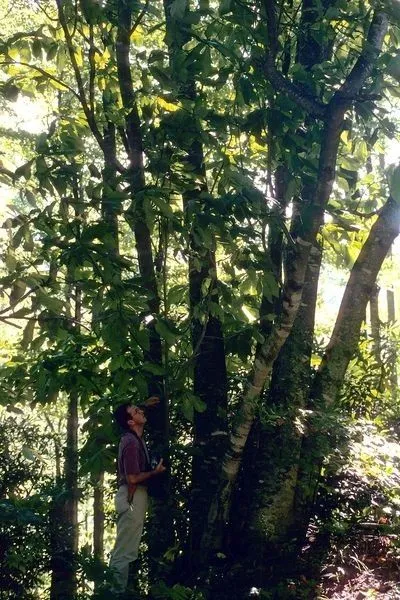
Author: Walter
Bibliography: Fl. Carol.: 159 (1788)
Year: 1788
Status: accepted
Rank: species
Genus: Magnolia
Vegetable: False
Observations: West Virginia to Texas
Fraser’s magnolia, scientifically known as Magnolia fraseri, is a distinctive and enchanting member of the Magnoliaceae family. The plant is named after the renowned Scottish botanist John Fraser, who explored the American Southeast in the 18th century. The first detailed description of this plant was published by Thomas Walter in his work Flora Caroliniana in 1788.
Found predominantly in the Appalachian region, Fraser’s magnolia thrives from West Virginia stretching down to Texas, making it a versatile species across the varied climates of the southeastern United States. This tree is characterized by its large, paddle-shaped leaves, which can grow up to a foot long, and its unique cucumber-shaped cone-like fruit, distinguishing it within its genus. The foliage turns a striking yellow in the fall, offering a picturesque view in its natural habitat.
One of the most striking features of Fraser’s magnolia is its fragrant, creamy white flowers, blooming in late spring to early summer. These flowers can reach an impressive diameter of up to 10 inches, making them a captivating element of the tree’s aesthetic. This eye-catching bloom period not only adds ornamental value but also plays a vital role in supporting local wildlife, particularly as a source of nectar for various pollinators like bees and butterflies.
In the wild, the Fraser’s magnolia prefers moist, well-drained soils, flourishing in the shaded understory of mixed hardwood forests. It has been observed to grow well in a variety of soil types, provided they are not overly dry. The tree typically reaches heights of 30 to 50 feet, with a broad, rounded crown, making it a stately addition to natural landscapes and larger gardens.
Despite its resilience, Fraser’s magnolia faces threats from habitat loss and climate change, which can alter its native ecosystems. Conservation efforts are essential to preserve this remarkable species for future generations to admire.
Overall, Magnolia fraseri stands as a testament to the botanical richness of the southeastern United States, offering both ecological benefits and striking beauty. Whether admired in natural settings or cultivated in managed landscapes, Fraser’s magnolia remains a symbol of the enduring elegance and diversity of America’s native flora.
Eng: fraser’s magnolia, ear-leaf umbrella-tree, mountain magnolia, ear-leaf umbrella tree
En: Fraser’s magnolia, Ear-leaf umbrella-tree, Mountain magnolia, Fraser Magnolia, Ear-Leaf Umbrella Tree
Ar: ماغنوليا فريزرية
Cs: Šácholan Fraserův
De: Berg-Magnolie
Kv: Фразер магнолия
Fa: مگنولیا فریزر
Taken May 4, 2004 by EOL − Bruce K. Kirchoff (cc-by-nc-sa)
Taken Jun 27, 2015 by EOL − dbroberts (cc-by-nc)
Taken Jul 12, 2021 by Olga Brito (cc-by-sa)
Taken Jul 12, 2021 by Olga Brito (cc-by-sa)
Taken May 26, 2021 by Spencer Hazeslip (cc-by-sa)
Taken Jan 1, 1900 by EOL − Howard, R.A. (cc-by-nc-sa)
Taken Jun 23, 2019 by desiree lynn (cc-by-sa)
Taken Apr 27, 2019 by kelly schultz (cc-by-sa)
Taken May 22, 2019 by Tom Jones (cc-by-sa)
Taken Oct 8, 2022 by sebastianmayr (cc-by-sa)
Taken Apr 3, 2009 by EOL − Chicago Botanic Garden 2009 (cc-by-nc-sa)
Taken May 31, 2002 by EOL − Steven J. Baskauf (cc-by-nc-sa)
Taken May 31, 2002 by EOL − Steven J. Baskauf (cc-by-nc-sa)
Taken Jul 9, 2015 by EOL − kmpetteruti (cc-by-nc)
Taken Oct 6, 2014 by EOL − Ann Walter-Fromson (cc-by-nc)
Taken Jul 4, 2020 by Jackie G (cc-by-sa)
Taken May 30, 2003 by EOL − Steven J. Baskauf (cc-by-nc-sa)
Taken May 31, 2002 by EOL − Steven J. Baskauf (cc-by-nc-sa)
Taken May 30, 2003 by EOL − Steven J. Baskauf (cc-by-nc-sa)
Taken Jul 12, 2021 by Olga Brito (cc-by-sa)
Taken Jun 7, 2021 by Philippe de Spoelberch (cc-by-sa)
Taken Jan 1, 1900 by EOL − WVU Herbarium (cc-by-nc-sa)
Taken Jan 1, 1900 by EOL − WVU Herbarium (cc-by-nc-sa)
Taken Sep 12, 2004 by EOL − Steven J. Baskauf (cc-by-nc-sa)
Taken Feb 20, 2022 by Nikolai Kurzenko (cc-by-sa)
Growth form>: Single Stem
Growth habit>: Tree
Growth rate>: Rapid
Ph maximum: 6.8
Ph minimum: 4.5
Family: Myrtaceae Author: (F.Muell.) K.D.Hill & L.A.S.Johnson Bibliography: Telopea 6: 402 (1995) Year: 1995 Status:…
Family: Rubiaceae Author: Pierre ex A.Froehner Bibliography: Notizbl. Bot. Gart. Berlin-Dahlem 1: 237 (1897) Year:…
Family: Sapindaceae Author: Koidz. Bibliography: J. Coll. Sci. Imp. Univ. Tokyo 32(1): 38 (1911) Year:…
Family: Asteraceae Author: A.Gray Bibliography: Pacif. Railr. Rep.: 107 (1857) Year: 1857 Status: accepted Rank:…
Family: Fabaceae Author: Medik. Bibliography: Vorles. Churpfälz. Phys.-Ökon. Ges. 2: 398 (1787) Year: 1787 Status:…
Family: Aspleniaceae Author: (Cav.) Alston Bibliography: Bull. Misc. Inform. Kew 1932: 309 (1932) Year: 1932…